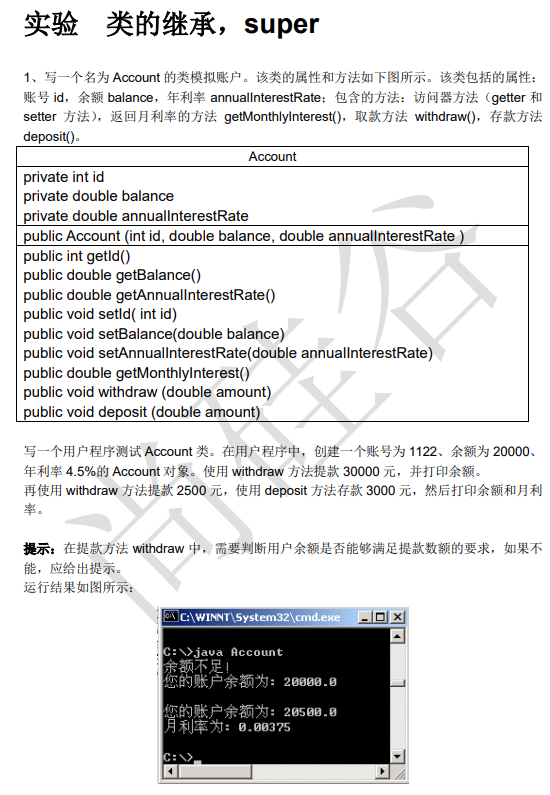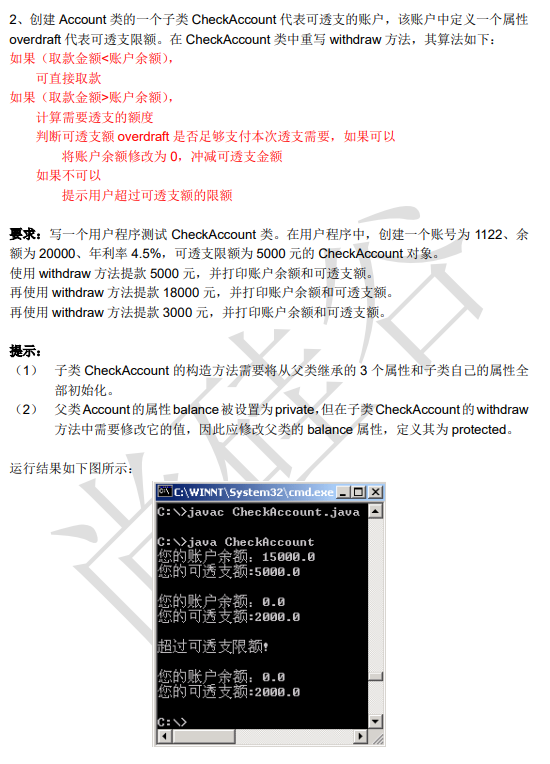super关键字的使用
1.super理解为:父类的
2.super可以用来调用:属性、方法、构造器
3.super的使用:调用属性和方法
3.1 我们可以在子类的方法或构造器中。通过使用"super.属性"或"super.方法"的方式,显式的调用
父类中声明的属性或方法。但是,通常情况下,我们习惯省略"super."
3.2 特殊情况:当子类和父类中定义了同名的属性时,我们要想在子类中调用父类中声明的属性,则必须显式的
使用"super.属性"的方式,表明调用的是父类中声明的属性。
3.3 特殊情况:当子类重写了父类中的方法以后,我们想在子类的方法中调用父类中被重写的方法时,则必须显式的
使用"super.方法"的方式,表明调用的是父类中被重写的方法。
4.super调用构造器
4.1 我们可以在子类的构造器中显式的使用"super(形参列表)"的方式,调用父类中声明的指定的构造器
4.2 “super(形参列表)”的使用,必须声明在子类构造器的首行!
4.3 我们在类的构造器中,针对于”this(形参列表)”或”super(形参列表)”只能二选一,不能同时出现
4.4 在构造器的首行,没有显式的声明”this(形参列表)”或”super(形参列表)”,则默认调用的是父类中空参的构造器:super()
4.5 在类的多个构造器中,至少有一个类的构造器中使用了”super(形参列表)”,调用父类中的构造器

子类对象实例化的全过程
从结果上来看:(继承性)
子类继承父类以后,就获取了父类中声明的属性或方法。
创建子类的对象,在堆空间中,就会加载所有父类中声明的属性。
从过程上来看:
当我们通过子类的构造器创建子类对象时,我们一定会直接或间接的调用其父类的构造器,进而调用父类的父类的构造器,...
直到调用了java.lang.Object类中空参的构造器为止。正因为加载过所有的父类的结构,所以才可以看到内存中有
父类中的结构,子类对象才可以考虑进行调用。
明确:虽然创建子类对象时,调用了父类的构造器,但是自始至终就创建过一个对象,即为new的子类对象。

综合练习:


1
2
3
4
5
6
7
8
9
10
11
12
13
14
15
16
17
18
19
20
21
22
23
24
25
26
27
28
29
30
31
32
33
34
35
36
37
38
39
40
41
42
43
44
45
46
47
48
49
50
51
52
53
54
55
56
57
| public class Account {
private int id;
private double balance;
private double annualInterestRate;
public Account(int id, double balance, double annualInterestRate) {
super();
this.id = id;
this.balance = balance;
this.annualInterestRate = annualInterestRate;
}
public int getId() {
return id;
}
public void setId(int id) {
this.id = id;
}
public double getBalance() {
return balance;
}
public void setBalance(double balance) {
this.balance = balance;
}
public double getAnnualInterestRate() {
return annualInterestRate;
}
public void setAnnualInterestRate(double annualInterestRate) {
this.annualInterestRate = annualInterestRate;
}
public double getMonthlyInterest(){
return annualInterestRate / 12;
}
public void withdraw (double amount){
if(balance >= amount){
balance -= amount;
return;
}
System.out.println("余额不足");
}
public void deposit (double amount){
if(amount > 0){
balance += amount;
}
}
}
|
1
2
3
4
5
6
7
8
9
10
11
12
13
14
15
16
17
18
19
20
21
22
23
24
25
26
27
28
29
|
public class AccountTest {
public static void main(String[] args) {
Account acct = new Account(1122, 20000, 0.045);
acct.withdraw(30000);
System.out.println("您的账户余额为:" + acct.getBalance());
acct.withdraw(2500);
System.out.println("您的账户余额为:" + acct.getBalance());
acct.deposit(3000);
System.out.println("您的账户余额为:" + acct.getBalance());
System.out.println("月利率为:" + (acct.getMonthlyInterest() * 100) +"%");
}
}
|
1
2
3
4
5
6
7
8
9
10
11
12
13
14
15
16
17
18
19
20
21
22
23
24
25
26
27
28
29
30
31
32
33
34
35
36
37
38
39
40
41
42
43
44
45
46
47
48
49
50
51
52
53
54
55
56
57
58
|
public class CheckAccount extends Account{
private double overdraft;
public CheckAccount(int id, double balance, double annualInterestRate,double overdraft){
super(id, balance, annualInterestRate);
this.overdraft = overdraft;
}
public double getOverdraft() {
return overdraft;
}
public void setOverdraft(double overdraft) {
this.overdraft = overdraft;
}
@Override
public void withdraw(double amount) {
if(getBalance() >= amount){
super.withdraw(amount);
}else if(overdraft >= amount - getBalance()){
overdraft -= (amount - getBalance());
super.withdraw(getBalance());
}else{
System.out.println("超过可透支限额!");
}
}
}
|
1
2
3
4
5
6
7
8
9
10
11
12
13
14
15
16
17
18
19
20
21
22
23
24
25
26
27
28
|
public class CheckAccountTest {
public static void main(String[] args) {
CheckAccount acct = new CheckAccount(1122, 20000, 0.045, 5000);
acct.withdraw(5000);
System.out.println("您的账户余额为:" + acct.getBalance());
System.out.println("您的可透支额度为:" + acct.getOverdraft());
acct.withdraw(18000);
System.out.println("您的账户余额为:" + acct.getBalance());
System.out.println("您的可透支额度为:" + acct.getOverdraft());
acct.withdraw(3000);
System.out.println("您的账户余额为:" + acct.getBalance());
System.out.println("您的可透支额度为:" + acct.getOverdraft());
}
}
|





